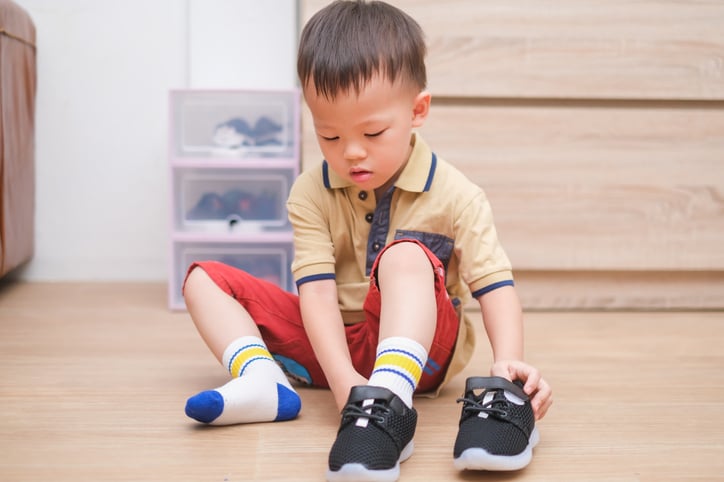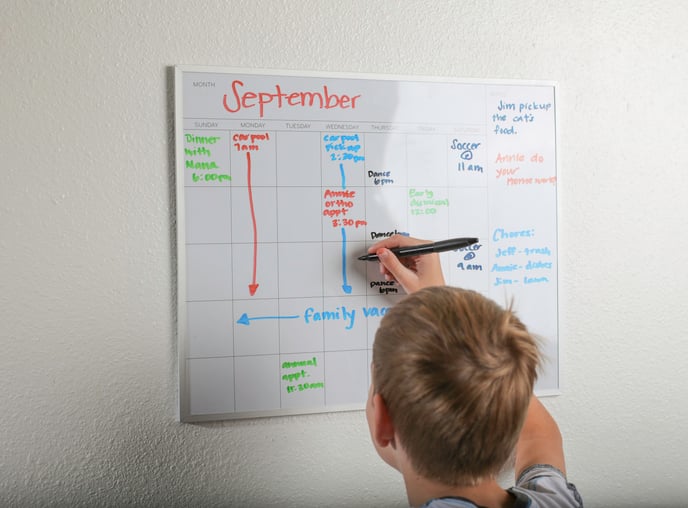7 Strategies for Supporting Individuals With Autism During Times of Transition and Change
Providing the proper support and interventions to children and adults with ASD can be a game changer in helping successfully manage changes in routines.
Imagine getting asked to change your daily routine–or being expected to go without a lunch break at work starting next week. It is probable that adjusting to these new changes would be challenging at first, and it might take a few weeks for you to fully acclimate to them, but most of us can acclimate relatively easily.
While adjusting to changes in routine can be fairly easy for some, others struggle significantly with changes of any kind. For those on the autism spectrum specifically, making schedule adjustments often creates difficult-to-navigate challenges that can be hard to overcome without the proper support, instruction, guidance, and intervention.
Rigidity and inflexibility are two common characteristics of autism, and the DSM-5 describes “insistence on sameness, inflexible adherence to routines, [and] ritualized patterns of verbal or nonverbal behavior” as part of the criteria for diagnosing autism spectrum disorder (ASD). Periods of transition–such as beginning a new school year, moving to a new house, or even adjusting to a different daily schedule–can present a variety of logistical challenges for those on the spectrum.
Specific difficulties related to making changes in routine for individuals with autism might include:
- A desire for sameness and familiarity in one’s daily schedule
- Difficulty understanding transition cues
- An insistence on predictability in the home, school, and treatment setting
- Anxiety and increased sensory sensitivities when changes are made
- Deficits in executive function (EF) skills–including focusing one’s attention, organizing, planning ahead, allocating working memory, and self-monitoring behaviors and emotions
- Restrictive or repetitive behaviors–like stimming, rocking, or rubbing one’s feet or clothing
- A strong desire to engage in special interests–such as playing with a favorite set of toy cars or action figures
- Reduced social interactions and limited engagement with others
Since these issues can cause significant difficulty for individuals with autism when adjusting to changes in routine, it is important to develop a transition plan designed to support each person’s unique goals.
Develop a Transition Plan
Although autistic individuals may present with an array of distinct social, communication, and behavioral challenges–with the right level of intervention and support–they can learn to thrive in their academic, home, leisure, and employment settings.
When addressing transitions of any kind, it is essential to, initially, consider the needs of each individual and then develop a transition plan to help the adjustment process take place as smoothly as possible. Strategies that can aid in the transition process for those on the autism spectrum include:
- Implementing transition cards and encouraging active engagement, participation, and progress toward goals.
- Developing a social narrative or video model to explain expectations during the transition process.
- Focusing on success and rewarding progress.
- Helping the individual cope with feelings of anxiety and stress in an appropriate and adaptive way.
- Preparing in advance to have downtime after a full day of activities, events, or changes in routine.
- Teaching the skills necessary for independence.
- Creating a sensory-friendly environment that can be used during periods of transition when the individual is overwhelmed, overstimulated, or having trouble calming down.

1. Implement transition cards and encourage active engagement, participation, and progress toward goals.
Task activity cards can be used to successfully establish a visual schedule–and to aid in the transition between one activity and the next. These cards can serve as prompts for chores, tasks, or homework that needs to be completed throughout the day, and they can also be implemented as reminders to help individuals transition from one activity to another.
To use transition cards as a visual schedule, simply stack them in a chronological pile or spread them out into a row. When a task is complete, have the individual move the appropriate card to the bottom of the chronological pile or to the end of the row.
This strategy serves as a visual reminder of the completed task, and it can aid in prompting the transition between activities or classes at school. Developing a visual schedule with task cards can also be an effective way to prepare individuals for transitions in general–and to help them become more independent in managing their personal routine on a daily basis. Encourage active participation, and be sure to fade out any prompts as quickly as possible.
2. Develop a social narrative or video model to explain expectations during the transition process.
Anticipate any challenges that may arise during periods of transition, and plan for what to do in the event of a schedule conflict. For instance, how will the individual cope with making an adjustment in the moment or change in their daily routine?
Social narratives and video models can be helpful tools because they provide tangible examples of what to expect when a disruption in routine occurs and how to respond when feeling overwhelmed or uncertain. Incorporating real-life footage of one’s academic, home, employment, and leisure settings into a video model or social narrative can provide an extra layer of support for those who are working to become acclimated to new schedule changes.
Video models and social narratives can also be used to illustrate effective coping mechanisms for alleviating feelings of stress, anxiety, and frustration in the moment. Two resources for supporting smooth transitions among those on the autism spectrum include:
- Autism Video Modeling: Handling Transition and Change
- Autism Transition Strategies: 5 Steps to Smoother Transitions
While implementing effective strategies for coping with changes in routine may require some focused practice initially, transitions will become easier over time as schedule adjustments are regularly adapted to.
3. Focus on success and reward progress.
No matter how big or small, be sure to place emphasis on celebrating progress, success, victories, and wins in every environment–including at home, at work, at school, and in therapy. Individuals with autism should, ideally, be working on similar goals across each setting, and it is also important to focus on incorporating reinforcement on a consistent basis.
If the individual is attending school, advocate for their IEP team to have regular meetings to discuss areas of progress and any presenting emotional, behavioral, or academic concerns. Implement a reinforcement schedule that is consistent in each setting and with each provider, educator, and parent. Celebrate all steps toward independence and personal gains.
At the very least, it is ideal to ensure that collaboration with the individual’s support team takes place regularly. Any conflicts or disagreements among professionals should be resolved as quickly as possible to prevent any setbacks or negative outcomes from occurring.
Consider gradually transitioning from extrinsic motivation to intrinsic as the individual grows, develops, and learns how to become more self-sufficient. An example of moving from extrinsic to intrinsic motivation could include:
- Having a student reward themselves for completing their classwork on time by placing a sticker on their chart instead of their teacher doing it.
- Then, phasing out the reward chart as the student is able to complete work on their own and starts using internal motivation (like knowing they will have more time after school to do the things they enjoy if they finish their classwork during class instead of in the evening at home).
Natural consequences and rewards should serve as the final source of reinforcement after contrived forms have faded out.

4. Help the individual cope with feelings of anxiety, stress, and being overwhelmed in an appropriate and adaptive way.
Coping with stress, anxiety, and feeling overwhelmed in an effective and non-destructive way is crucial to the success of those on the spectrum. Healthy coping strategies should be taught, targeted, and implemented across all relevant settings–and it is important to regularly practice these skills in the community to generalize coping strategies across multiple contexts.
Occupational therapists, physical therapists, behavior therapists, and skilled educators who are trained in teaching coping skills can help implement effective strategies for stress reduction while also including tactics for self-regulation. Some common suggestions include:
- Making small, manageable changes over time
- Providing defined breaks from difficult situations as needed
- Using timers, transition cards, and verbal reminders to cue a change from one activity to the next
- Remaining flexible and providing extra time between transitions
- Incorporating calming music into one’s daily routine–especially during stressful schedule changes
- Stimulating the senses with sensory toys–like fidget cubes, stress balls, or modeling clay
- Keeping earplugs, noise-canceling headphones, and sunglasses on hand for use in particularly overwhelming settings
- Exercising, creating a gratitude list, and deep breathing
Coping strategies give individuals the opportunity to use effective skills for stress management when they are becoming frustrated by transitions or schedule changes.
5. Prepare to have downtime after a full day of activities, events, or changes in routine.
If possible, try not to schedule any additional appointments or activities immediately after a full day of events, stressful social gatherings, or on a day that requires a significant schedule adjustment. Have soothing activities–like music, a TV show, or a snack–ready to go as soon as the event or change in routine is over because this will give the individual something to look forward to. Incorporate self-care skills and practice strategies that can be used independently when changes arise.
6. Teach the skills necessary for independence.
Teaching independence skills is another important area of focus. These complementary skills can include goals like:
- Independently tying one’s shoes
- Connecting Velcro
- Zipping zippers
- Following directions in different settings and with different people
- Remaining quiet and calm during transition times
It might also be beneficial to practice speaking in the community setting. If one uses an assistive communication device (AAC), for example, consider using it when shopping at the store or working with support providers–such as an occupational therapist or peer mentor. Rehearse simple questions like “Where is the bathroom?” and use statements like “I need help please.” This will allow the individual to generalize their communication and independence skills across multiple contexts.

7. Create a sensory-friendly environment that can be used during periods of transition when the individual is overwhelmed, overstimulated, or having trouble calming down.
To help those on the spectrum calm down, it can be helpful to have a sensory-friendly environment to go to at home, work, or school. To create this, teach the individual to identify signs or cues that they are becoming frustrated, overwhelmed, or upset, and instruct them to request a break in the sensory room.
If necessary, place limits on the number of visits the individual takes to the sensory room. This calm-down space should not be used to get out of work or tasks that the individual doesn’t want to complete. Instead, it should be used to help develop self-regulation skills during times of feeling overwhelmed and overstimulated. Learning to ask for help and request a break when needed is an invaluable tool that can help one regulate their thoughts, actions, and emotions.
In Summary
It is crucial to regularly evaluate each strategy and intervention being used to determine its usefulness and effectiveness. Remember that difficulty with changes in routine and daily activities is a hallmark characteristic of autism. However, once skills are learned and adjustments to changes in routine become easier, consider gradually fading out the interventions being used, and plan for the implementation of a new procedure if needed. Practice is key to progress and success!
Take a look at our free checklist on strategies to support your child with autism through times of transition!
What strategies have you found useful to help those on the spectrum make transitions successfully?
This article was based, in part, on the following sources:
https://www.cdc.gov/ncbddd/autism/hcp-dsm.html
https://childmind.org/article/helping-special-needs-kids-change-schools/
https://www.ncbi.nlm.nih.gov/pmc/articles/PMC5632603/
https://operationautism.org/transitions/
https://raisingchildren.net.au/autism/behaviour/understanding-behaviour/changing-routines-asd

Kenna McEvoy
Kenna has a background working with children on the autism spectrum and enjoys supporting, encouraging, and motivating others to reach their full potential. She holds a bachelor's degree with graduate-level coursework in applied behavior analysis and autism spectrum disorders. During her experience as a direct therapist for children on the autism spectrum, she developed a passion for advocating for the health and well-being of those she serves in the areas of behavior change, parenting, education, and medical/mental health.






